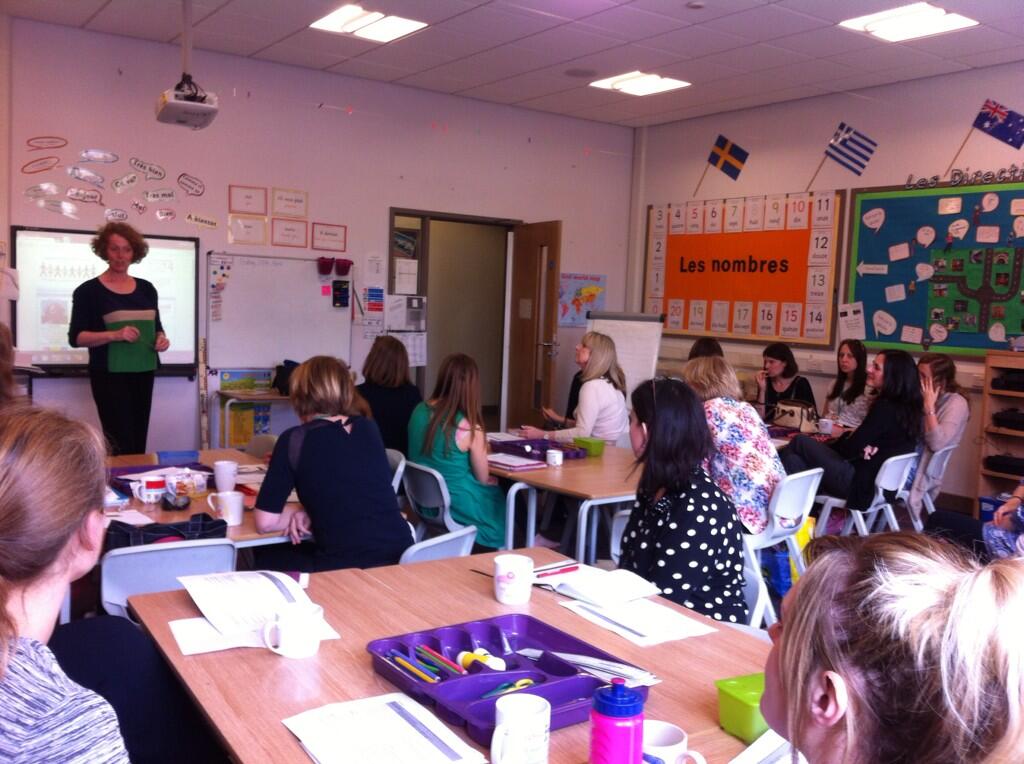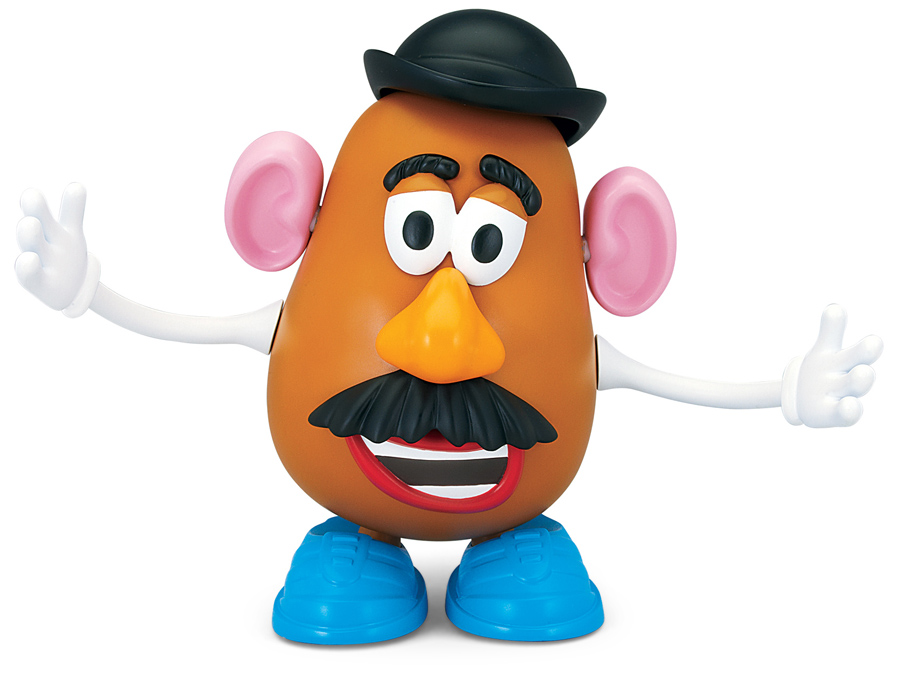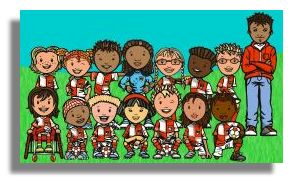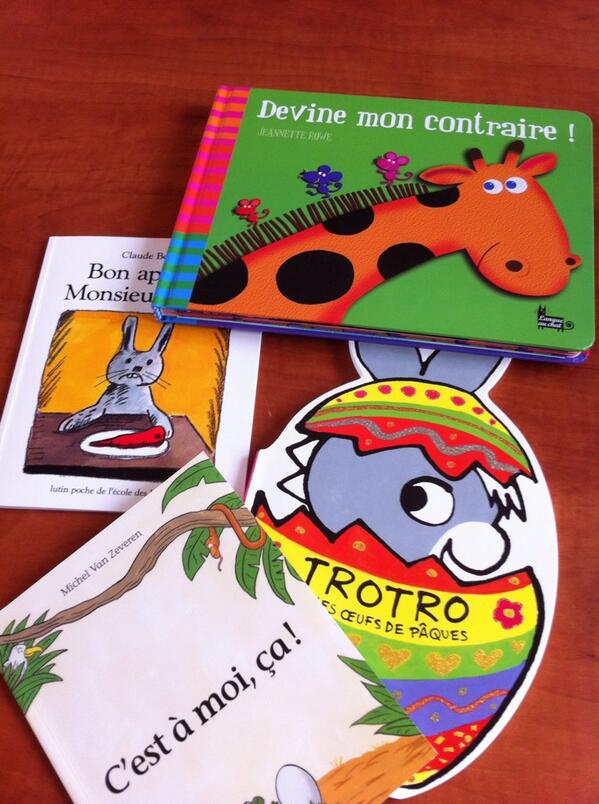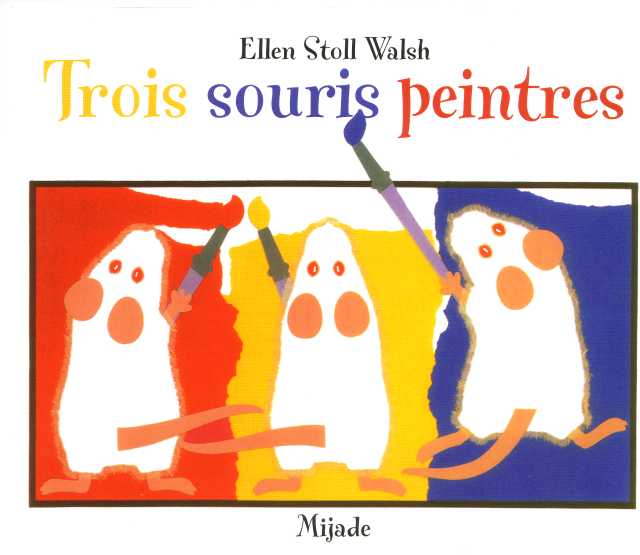Laying the foundations for future language learning……
Our
Show Tell and Share
Yesterday we held our “Show tell and share” network meeting (24
April 2014) in Mandy’s language room at Stockton Heath Primary School,
Warrington.
40 primary school colleagues attended the event .Eight colleagues
had been invited to share ideas, or a
simple practical sequence of lessons in short 5-10- minute presentations.
It’s important to understand that the colleagues who were
brave enough to show, tell and share are primary language practitioners who
deliver languages in their own schools every week of the year- one Head
teacher, three primary classroom teachers, three teaching assistants and a
visiting teacher.
They represent a cross section of 90 schools in the network and different
stages of primary language progress (starting off, moving on and established practice). Most importantly the ideas were practical and replicable and
teachers and teaching assistants in the audience could take ideas for primary language learning
back to their own schools and try them
out.
Illness and monsters
Cathy, from Appleton Thorn CP shared all her creative ways
of developing a unit on illness and parts of the body. She stressed the
importance of sounds and recognition of the spoken word before showing children
the written word. She explained how she feels that this is necessary to enable all children to make the link
smoothly between spoken and written language. Her focus on sounds and patterns
and investigating the words helps her children to confidently use the words and
find new language they want to say in dictionaries etc. Cathy encouraged us to
ask children to look for cognates and near cognates and to link games and practical
work with more creative art and design opportunities.
In this sequence of activities
Cathy was using work around fantastical creatures – Frankenstein type monsters to engage the
children in learning parts of the body so that they could then develop role
plays on familiar everyday matters – going to the doctors and explaining simple
illnesses.
E Twinning Project
with Spain
Ian from Cronton CE, one of our Knowsley schools, shared how
the school had developed an ETwinning project with their new link school in
Spain .The school already has an established link with a German school.
The
project was for Year 3 in their first year of Spanish and was based around learning
simple weather phrases. Ian’s input was the language element and the
coordination with the Spanish school.
Every day of each week that the project was happening(Autumn 2013), the class TA worked with a different group of 4 children to record in Spanish the temperature, the weather and dressed in clothes appropriate to the weather to create a photo record .
At the end of each week the group created the class weather report in Spanish plus photos via Pic Collage and sent this by email to their Spanish school.
The mail exchange
of the Pic Collage reports raised all sorts of interesting points for example
what were the Spanish children doing roasting
chestnuts in the playground for a chestnut festival instead of an ordinary
school day! Ian’s project show how we are opening the door on new cultures and
laying foundations and interest in purposeful practical future language learning
The verb être
Sam from St Philips CE got us thinking about how easily we
can integrate work around verbs into our everyday language learning in the
primary classroom. She has just run a focus on the verb être as part of the Y6 children’s work on “Who am
I? We loved the video clip she sourced and used and the simplified rap song she created with
the children from the French language in this clip
The children created spider grams of the verbs for example using a sunshine and the beams off a sunshine to show the infinitive of the verb to be and its present tense parts
Sam organised the children in groups of 6 so that they could record themselves introduce one another using the verb être and all its present tense parts.She appeared in all the clips so that the children could understand why and how to use “vous êtes” accurately .We were impressed how all the children participated and could use the different parts of the verb! Simple effective use of technology which lays the foundations for future grammatical language learning in KS3.
(Sam will share more from this project soon on network news )
Mr Potato Head
transferable games
Karen from Cinnamon Brow CE talked with us about her work
using Mr Potato Head to reinforce familiar language on parts of the body. The
activities were obviously transferable and at this point teachers who work
alongside visiting teachers were animatedly jotting down ideas they could use
to follow up or reinforce language learning.
For example everyone loved the Mr
Potato Head photo shoot that Karen had created (and one teacher said to me “I
will get my children to do this”).
They liked the use of the same pictures for simple hide and
reveal – not high tech but practical and hands on , using A4 envelopes to
slowly reveal Mr Potato Head. Karen suggested that the children can play this
again afterwards on their own. Taking
the familiar primary “hide and reveal” technique again , Karen shared how she
would ask the children to anticipate what missing facial parts there may be on
Mr Potato Head in each new game .Simple, effective and activities we could
transfer from one core focus to another
and that encourage the participation of all children and understanding ways to
make learning fun.
Everyone shares!
Then it was time for us all to share- something that they
use in their everyday work as primary practitioners of foreign languages!
I love this photo of Ian and Emma deep in conversation. Emma
is a French coordinator
and she was keen to learn as much as possible about E Twinning and next steps for her school!
Human sentences and
position of adjectives
Christine from Westbrook Old Hall had taken the time to
consider a sequence of five lessons on monsters she delivered in the Autumn
term 2013 with Y6
The children in Year 6
revisited their prior knowledge of
body parts, number, colours from previous years in KS2 and discussed and
demonstrated their understanding from Y5 of the position of adjectives after
the noun .Her focus in Year 6 was to look at the position of adjectives such as
grand and petit before the noun and to
encourage the children to speak and write accurately using their knowledge of
adjectival agreement. She used Singing
French and the monster song to reinforce prior knowledge and to encourage performance.
The children looked at the adjectives grand/petit and the position they appear
in French sentences and worked out what was different here to adjectives of
colour.
Christine read Grand Monstre Vert with the children and they
investigated the position of the adjectives
in the sentences .
They played human
sentence games ordering
the words in
French human sentences.The slide shows how she used a ppt slide
to first ask the children to create verbally sentences in French from an
English stimulus and then revealed the sentence written correctly on the
monster slide.
At this point Emilie,our native speaker visiting teacher-
formerly a secondary teacher tweeted ……….
Really nice to hear primary MFL teachers / assistants mentioning grammar & dictionary skills as part of their teaching #showtell
Town investigations
with young learners
Lis
from St Ann’s CE and Mandy from Stockton Heath CP talked about the town and how
they created their two sequences of lessons based on shops in the town and
directions.
What was fascinating was how both of them identified key points to
consider – very practical primary points. They considered the experience,
maturity and age of their primary learners carefully as they planned the
activities.
Firstly that the children need to be guided to think of names of
shops as they automatically when talking about a town would say H+M,
Tescos etc and not butchers, cake shop ,
bakery.
Lis spent time talking about the town her children know best –
Warrington-and then guiding them to talk about the names of the types of shops
they had mentioned. Mandy shared with them various maps of French towns and
pictures of buildings you would find there so she could then hold a discussion with the children about
which shops they might need to ask for in French.
Both Lis and Mandy reinforced
the cultural differences – how in France you still go to the bakers, butchers
etc. Simple discussion maybe... but really important in laying the foundations for
future cultural understanding that bridges the gap between what the children
have experienced and what we might want them to learn about. Both Lis and Mandy
worked with the children on directions and developed physical activities – Lis
had a human street and used follow me cards to create role plays.
Mandy had the children moving to visuals around the room and
then she generated with the children a class map and display of a French town.
Each child was given a cut out character and had to write a sentence to give directions to a partner on where to
place the cut out character on the
display.
The ideas were simple, effective and addressed
familiar matters and useful questions
and answers laying the foundations upon
which to build more detailed role play and transactional conversations.
Activities which
reinforce good practice and language skills
Last but not least was Jayne @Dewsnip_Jayne, a visiting
teacher for JLN. Jayne explained that she was a secondary languages teacher.
However over the last three years working as part of the network in 5 primary
schools she had found the freedom of the primary classroom a revelation! She
has learned so much from her primary colleagues and the children about how
children learn a primary foreign language.
She shared with us her bilingual
dictionary work based on Arcimboldo with UKS"2 children.
They investigated what the mystery letters after
the words in the dictionary mean (m/f/pl/nm etc) so that they could create
their own written and art posters of the Arcimboldo face(link to Jaynes
arcimboldo pics) Jayne could see that this would help the children in KS3 language learning.
Jayne shared her simple
game “guess the combination” where from a table of 9 key words e.g. fruits the
children guess the combination of three she has secretly written down . Jayne
identified that she focused on accurate pronunciation and perhaps without
realising this Jayne is once again encouraging good habits before KS3 .
Her
puzzle game- simple cut up pictures is easy to replicate and use across all
language areas. You need a minimum of two pictures from a core focus or a mixed
focus , with a number and colour on the reverse .Children must ask politely for
a number and a colour so that a part the puzzle can be revealed .Can the children guess
and name the item correctly with the definite article or indefinite article?
The final activity she shared was her work on
adjectival agreement when describing a male or a female and how easily she was able
to reinforce this with her mother’s day flowers.
Working in
primary and developing creative primary approaches ,Jayne is reinforcing and
encouraging good language skills and knowledge so that KS3 can build upon
quality foundations laid in primary foreign language learning.
The overwhelming impression from this event is that we
are making good “practical primary progress”. It’s not rocket
science and it’s not always all singing and dancing. My colleagues are developing
a curriculum in their own schools that is fit for purpose.
In the range of
presentations we heard about the four skills of listening, speaking, reading
and writing and combinations of these skills to move the children on in their
learning in every lesson and consolidate prior knowledge! We were asked to
consider culture and links abroad and ways to link language learning to other
subject areas in the primary curriculum and colleagues shared how they were
encouraging the children to consider the structure and grammar of the language.











